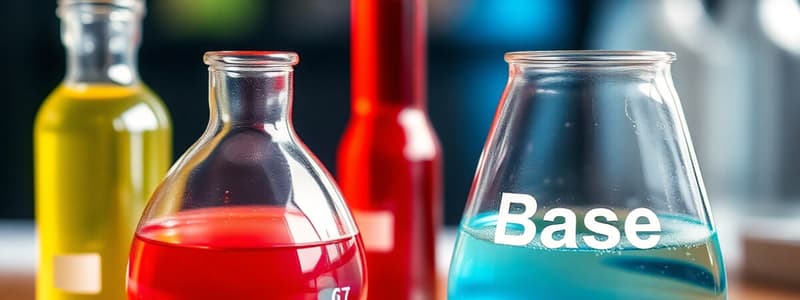Podcast
Questions and Answers
How does the Brønsted-Lowry definition of acids and bases differ fundamentally from earlier definitions?
How does the Brønsted-Lowry definition of acids and bases differ fundamentally from earlier definitions?
- It focuses solely on the production of hydroxide ions in aqueous solutions.
- It introduces the concept of pH as a measure of acidity and basicity.
- It restricts the definition to only include strong acids and bases.
- It broadens the definition to include substances that can donate or accept protons, not just those affecting hydroxide ion concentration. (correct)
Ammonia (NH3) is considered a base even though it does not contain OH- ions in its formula. What mechanism allows it to act as a base?
Ammonia (NH3) is considered a base even though it does not contain OH- ions in its formula. What mechanism allows it to act as a base?
- Ammonia donates protons to water molecules, increasing hydronium ion concentration.
- Ammonia acts as a strong acid, neutralizing any bases present.
- Ammonia directly releases hydroxide ions into a solution.
- Ammonia undergoes hydrolysis, reacting with water to generate hydroxide ions. (correct)
What property defines a substance as amphiprotic?
What property defines a substance as amphiprotic?
- The ability to act only as a proton acceptor.
- The ability to neutralize both strong acids and strong bases simultaneously.
- The ability to act as either a proton donor or a proton acceptor. (correct)
- The ability to act only as a proton donor.
A scientist discovers a new compound and finds that its aqueous solution has a pH of 9. Based on this information, how would you classify the compound?
A scientist discovers a new compound and finds that its aqueous solution has a pH of 9. Based on this information, how would you classify the compound?
Given the equation for pH, $pH = -log[H_3O^+]$, how does a tenfold increase in the hydronium ion concentration, $[H_3O^+]$, affect the pH of a solution?
Given the equation for pH, $pH = -log[H_3O^+]$, how does a tenfold increase in the hydronium ion concentration, $[H_3O^+]$, affect the pH of a solution?
At room temperature, the self-ionization of water is described by the equation $Kw = [H_3O^+][OH^-] = 1.0 imes 10^{-14}$. If a solution has a hydronium ion concentration of $1.0 imes 10^{-5}$ M, what is the hydroxide ion concentration, and what is the pH?
At room temperature, the self-ionization of water is described by the equation $Kw = [H_3O^+][OH^-] = 1.0 imes 10^{-14}$. If a solution has a hydronium ion concentration of $1.0 imes 10^{-5}$ M, what is the hydroxide ion concentration, and what is the pH?
How does the behavior of strong acids and bases in aqueous solutions differ from that of weak acids and bases?
How does the behavior of strong acids and bases in aqueous solutions differ from that of weak acids and bases?
For a weak acid, the acid dissociation constant, $K_a$, is defined as $K_a =
rac{([H_3O^+][A^-])}{[HA]}$. What does a smaller $K_a$ value indicate about the strength of the acid?
For a weak acid, the acid dissociation constant, $K_a$, is defined as $K_a = rac{([H_3O^+][A^-])}{[HA]}$. What does a smaller $K_a$ value indicate about the strength of the acid?
A buffer solution is prepared to maintain a stable pH. What is the primary mechanism by which a buffer resists changes in pH upon the addition of small amounts of acid or base?
A buffer solution is prepared to maintain a stable pH. What is the primary mechanism by which a buffer resists changes in pH upon the addition of small amounts of acid or base?
The buffer capacity is defined as the amount of acid or base that can be added before the pH begins to change significantly. How is buffer capacity quantitatively defined?
The buffer capacity is defined as the amount of acid or base that can be added before the pH begins to change significantly. How is buffer capacity quantitatively defined?
How would the Arrhenius definition classify $CH_3COOH$ in an aqueous solution?
How would the Arrhenius definition classify $CH_3COOH$ in an aqueous solution?
Which statement correctly describes the roles of Johannes Bronsted and Thomas Lowry in defining acids and bases?
Which statement correctly describes the roles of Johannes Bronsted and Thomas Lowry in defining acids and bases?
In a chemical reaction, water can act as both a proton donor and a proton acceptor. What term describes substances with this dual capability?
In a chemical reaction, water can act as both a proton donor and a proton acceptor. What term describes substances with this dual capability?
What approach did Soren Sorensen introduce in 1909 to quantify acidity and basicity in aqueous solutions more conveniently?
What approach did Soren Sorensen introduce in 1909 to quantify acidity and basicity in aqueous solutions more conveniently?
Given $pKw = pH + pOH = 14$ at room temperature, if a solution has a $pH$ of 6.0, what is its $pOH$ and how does this relate to its acidity or basicity?
Given $pKw = pH + pOH = 14$ at room temperature, if a solution has a $pH$ of 6.0, what is its $pOH$ and how does this relate to its acidity or basicity?
How does calculating the hydronium ion concentration in a strong acid solution differ from that of a weak acid solution?
How does calculating the hydronium ion concentration in a strong acid solution differ from that of a weak acid solution?
For a weak base, the base dissociation constant, $K_b$, is represented as $Kb =
rac{([OH^-][B^+])}{[B]}$. What does this constant indicate about the strength of the weak base?
For a weak base, the base dissociation constant, $K_b$, is represented as $Kb = rac{([OH^-][B^+])}{[B]}$. What does this constant indicate about the strength of the weak base?
How does adding a strong acid to a buffer solution affect the equilibrium and what components of the buffer system counteract this addition?
How does adding a strong acid to a buffer solution affect the equilibrium and what components of the buffer system counteract this addition?
A laboratory technician prepares a buffer solution for an experiment but finds that adding only a small amount of acid causes a significant pH change. What is the most likely reason for this?
A laboratory technician prepares a buffer solution for an experiment but finds that adding only a small amount of acid causes a significant pH change. What is the most likely reason for this?
Why is the concept of buffer capacity important in biological systems, such as blood, and what happens if the buffer capacity is exceeded?
Why is the concept of buffer capacity important in biological systems, such as blood, and what happens if the buffer capacity is exceeded?
Flashcards
Bronsted-Lowry Acid
Bronsted-Lowry Acid
In the Bronsted-Lowry definition, it donates protons.
Bronsted-Lowry Base
Bronsted-Lowry Base
In the Bronsted-Lowry definition, it accepts protons.
Arrhenius Acid
Arrhenius Acid
Arrhenius acid is a compound that increases the H+ ion concentration in an aqueous solution.
Arrhenius Base
Arrhenius Base
Signup and view all the flashcards
Ammonia (NH3) as a Base
Ammonia (NH3) as a Base
Signup and view all the flashcards
Amphiprotic Substance
Amphiprotic Substance
Signup and view all the flashcards
pH Testing
pH Testing
Signup and view all the flashcards
Neutral pH
Neutral pH
Signup and view all the flashcards
Acidic pH
Acidic pH
Signup and view all the flashcards
Basic pH
Basic pH
Signup and view all the flashcards
pH Equation
pH Equation
Signup and view all the flashcards
Self-ionization of water
Self-ionization of water
Signup and view all the flashcards
pKw equation
pKw equation
Signup and view all the flashcards
Strong Acid
Strong Acid
Signup and view all the flashcards
Strong Base
Strong Base
Signup and view all the flashcards
Weak Acids
Weak Acids
Signup and view all the flashcards
Weak Bases
Weak Bases
Signup and view all the flashcards
Buffer
Buffer
Signup and view all the flashcards
Buffer Capacity
Buffer Capacity
Signup and view all the flashcards
Study Notes
- Acids and Bases are fundamental concepts in chemistry.
Bronsted-Lowry Definition
- In 1923, Johannes Bronsted and Thomas Lowry independently defined acids and bases based on proton transfer.
- An acid is a proton donor (PD).
- A base is a proton acceptor (PA).
Arrhenius Definition
- An Arrhenius acid increases the H+ ion concentration in an aqueous solution.
- An Arrhenius base increases the OH- ion concentration in an aqueous solution.
Ammonia as a Base
- Ammonia (NH3) is a base that does not contain OH- ions in its formula.
- Ammonia generates OH- ions through a proton-transfer reaction with H2O molecules.
- The reaction of ammonia with water is called hydrolysis.
Amphiprotic Substances
- H2O can act as both a proton donor and a proton acceptor, depending on the chemical reaction.
- A substance that can act as a PD or a PA is called amphiprotic.
pH Testing
- pH testing, or potential of hydrogen ion, is used to test if a substance is acidic or basic.
- Soren Sorensen, a Danish biochemist, proposed pH testing in 1909 to conveniently describe hydronium and hydroxide ion concentrations in aqueous solutions.
- The pH scale ranges from 0 to 14 in water.
- A pH of 7 is considered neutral.
- A pH less than 7 is considered acidic.
- A pH greater than 7 is considered basic.
- The equation to determine the pH of an aqueous solution is pH= -log(H3O+).
Self-ionization of Water
- At room temperature, Kw = (H3O+)(OH-) = 1.0 x 10-14.
- pKw = pH + pOH = 14.
Strong Acids and Bases
- When calculating hydronium concentration in a strong acid, the strong acid is the main source of hydronium ions.
- When calculating hydroxide concentration in a strong base, the strong base is the main source of hydroxide ions.
Weak Acids and Bases
- Weak acids only partially dissociate in aqueous solutions and reach a condition of equilibrium.
- Ka = (H3O+)(A-)/HA
- Weak bases only partially dissociate in aqueous solutions and reach a condition of equilibrium.
- Kb = (OH-)(B+)/B
Buffers
- A buffer is a special solution that stops massive changes in pH levels.
- Every buffer has a certain buffer capacity and buffer range.
- Buffer capacity is the amount of acid or base that can be added before the pH begins to change significantly.
- Buffer capacity can also be defined as the quantity of strong acid or base needed to change the pH of one liter of solution by one pH unit.
Studying That Suits You
Use AI to generate personalized quizzes and flashcards to suit your learning preferences.




